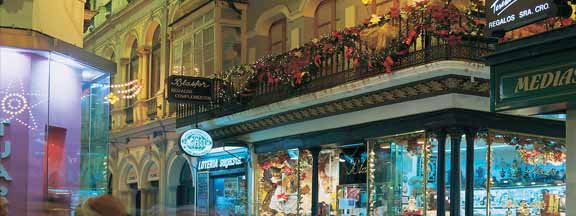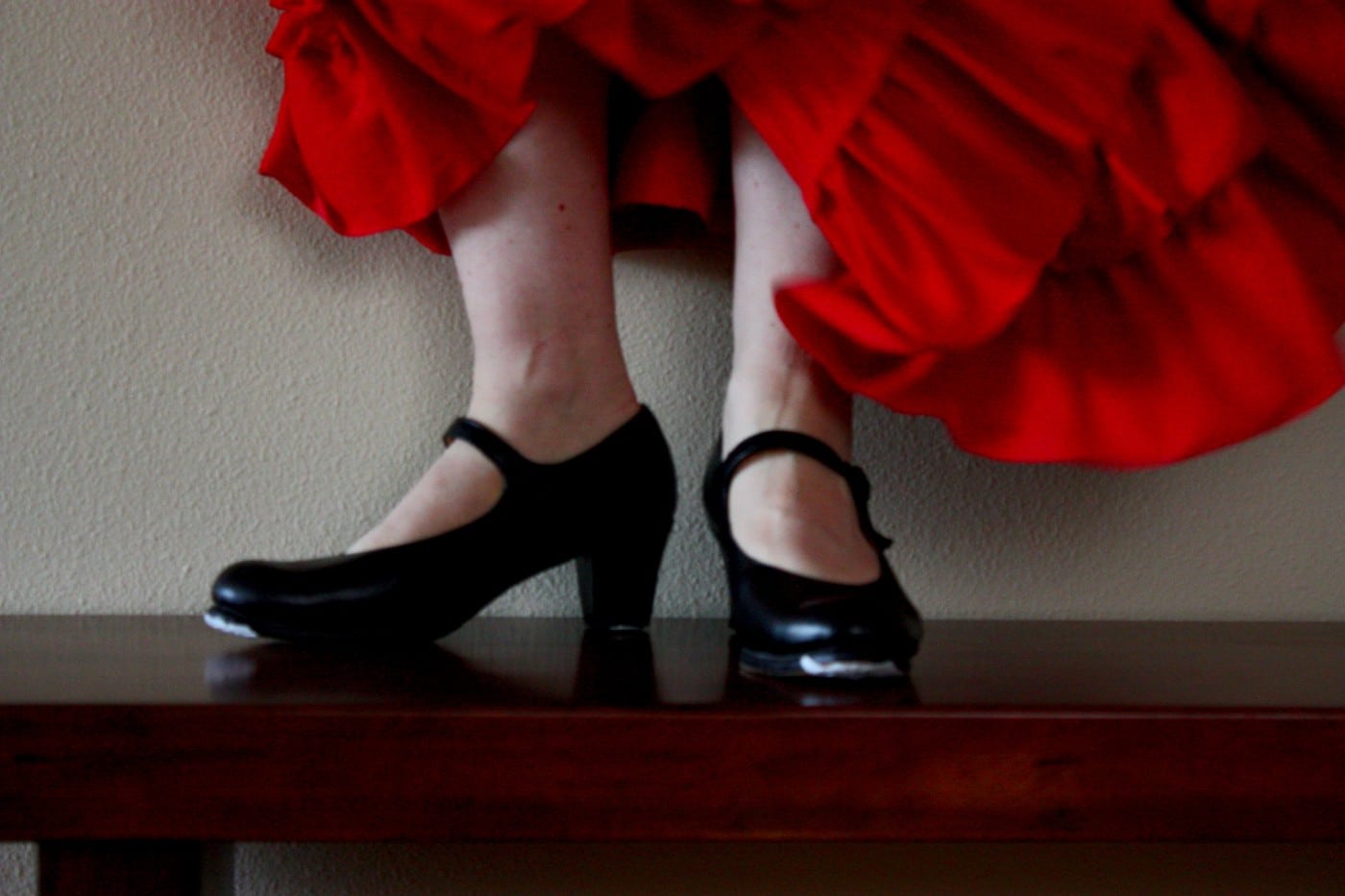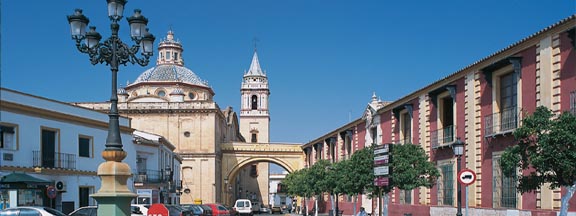
The sounds of stamping feet and lustily strummed guitars burst from every corner of this radiant city during the Bienal de Flamenco, which takes place this year from September 15-October 9. Day and night, in 16th-century plazas and Art Deco theaters, top-flight dancers and musicians celebrate the art over a four-week period packed with performances, workshops and classes. “It’s a fantastic time to visit,” says Miguel Marin, who presents Flamenco Festival USA every year, and grew up in a nearby village. “It’s where I go to find the best new artists and to see the legends perform. The city comes totally alive.”
Since its founding in 1980, the Bienal has become the most popular and sophisticated festival of its kind, drawing fans to southern Spain from all over the world. Flamenco festivals are as integral to Andalusian life as sunshine and red wine, with almost every village known for its own individual style. It is where youngsters learn to perform, artists hone their skills and legends assert their supremacy. “You breathe flamenco here,” says the dancer Eva Yerbabuena, who will perform with her company October 5-6. “It’s like weather; it’s like family.’
Flamenco, a combination of Moorish, Jewish, Gypsy and southern Spanish cultures, evolved in Andalusia more than 200 years ago and remains at the heart of this beautiful and rugged region. Wandering in Seville intensifies your understanding of the fiery art form and everything that contributes to the region’s vibrant character, built layer upon layer over 2,000 years by Phoenicians, Carthaginians, Romans, Visigoths, Moslems and Christians. After visiting its monuments, gardens and cobblestone streets, you are well prepared for evenings of flamenco, for in these places lies the origins of the passionate stories that fill the flamenco repertory.
According to legend, Hercules founded Seville on the banks of the Guadalquivir River but its actual origin goes back to the Tartessian civilization of the lst century. Now best known for Christopher Columbus, Carmen, Don Juan and Figaro, it offers visitors an abundance of history, art and beauty. Since you will often hear the city’s architecture and design described as being in the Mudajer style – the curving archways, tiled walls and floors and secluded patios – it is helpful to know that the term itself means “those who accepted submission” because the style was created by the Moors who bowed to Christian rule after their defeat in the 15th century. As such, it developed as a symbiosis of Muslim and Christian architectural philosophies and techniques, with brick used as the main material.
While each narrow alley and leafy patio resonates with times gone by, the Barrio de Santa Cruz, formerly the Jewish quarter, in the city’s center boasts enough sights – and tapas bars – to keep you engrossed, and well fed, for days. The majestic Santa Iglesia Cathedral makes a good place to begin your explorations. A Gothic temple constructed on the rectangular base of the Almohad Mosque, it retains two major parts incorporated within the new design.
The first of these, the Patio de los Naranjos, situated just outside the Cathedral, dates back to Moorish times when worshippers would wash their hands and feet in the fountain here – under the orange trees – before their daily prayer. The other remaining element is the brightly decorated minaret converted into a bell tower, La Giralda, which is now more than 90 meters high. From El Giraldillo, the weather vane on the top, you have expansive views across the city.
The Cathedral’s central nave rises to a breathtaking 42 meters and even the side chapels seem tall enough to contain an ordinary church. The total area covers 11,520 square meters, and qualifies it to be one of the largest churches in the world, along with Saint Paul’s in London and Saint Peter’s in Rome. But what leaves a more lasting impression than its size is the interior’s graceful symmetry and restrained decoration. Here you find the box-like choir, with 117 stalls carved in the Mudéjar style, and an enormous Gothic altarpiece, decorated with carvings of Biblical scenes, including works by Goya, Zubarán and Murillo. One of the most impressive and controversial parts of the Cathedral is the tomb of Christopher Columbus. A highly imposing monument, scientists question whether or not any part of the great explorer’s remains are actually contained within it.
History buffs should check out The Archivo General de Indias nearby. Built as an exchange so that traders would not use the Courtyard of Orange Trees and the cathedral as places of business, it houses extremely valuable archival documents illustrating the history of the Spanish Empire in the Americas and the Philippines.
To round off your walk in the Barrio Santa Cruz, explore the Alcazar, probably the finest example of the Mudejar style in the world. Once a Moorish palace not unlike the Alhambra in nearby Granada, it was a palace-fortress under the Moors. When the city fell to the Christian reconquest in 1248, much of the fort was damaged and subsequently turned into ruins. But in the late 14th century the palace was rebuilt over the ruins by Moors living under Christian rule, allowing the fortress to retain its distinctly Moorish character. The oldest royal residence still in use in Spain, the Spanish royal family stays here when they visit the city.
You enter through the Puerta del Leon, which is emblazoned with the royal lion. The interior is comprised of many sections, the most impressive being the Patio de las Doncellas, or Courtyard of the Maidens. With its shimmering pool set in an elegant, two-story courtyard, framed by burnished arches delicately carved of wood, and shielded from the direct rays of the sun, it feels like an oasis, hidden away from the hustle and bustle of everyday life. Each bedroom, meeting hall and courtyard conveys some of this sweet serenity. It carries into the surroundings gardens and courtyards, bounded by arcades and sequestered behind high walls. Here you find glittering pools, fountains, and recessed seats. Decorative grilles enhance lush views of the palms, cypresses, myrtles, mulberries, magnolia, orange and lemon trees. It resembles an Eden.
As the day ends and the cafes begin filling up, you can choose among hundreds of places to soak up the atmosphere before a late dinner or a performance or both. Even when the Bienal is not on, the city has enough bars and clubs with music and flamenco to keep anyone happy. Sevillanos don’t go to bed before dawn so there’s no rush, just a joyful and welcoming spirit to carry you through the night.
[box bg=”#ccc”]
The country code for Spain is (34).
Where to Sleep:
EME Cathedral Hotel – Located in the heart of town, this dazzling, new hotel, comprised of fourteen 18th and 19th century houses grouped together, boasts a glamorous rooftop pool and bar, incredible views, terraces, luxurious spa and four restaurants. 60 rooms. Alemanes 27, 34 95 456 00 00 http://www.emecatedralhotel.com
Casa Número 7 – A small beautiful 19th century mansion, with 6 rooms decorated with antiques, plus a butler to serve you breakfast. Near the center of town. Vírgenes 7, 34 95 422 15 81 www.casanumero7.com
Hospes las Casas del Rey de Baeza – A boutique hotel in a converted 18th-century monastery, with 41 Andalusian style rooms surrounding a courtyard. Rooftop pool. Calle Santiago 2, Plaza Jesus de la Redención, 34 954 56 1496; www.fuenso.com
Where to Drink and Eat
(Lunch is often not served until 2 pm and dinner until 11 pm but tapas bars are always there to tide you over. The best places are downtown, around the bullring in the el Arenal and Triana districts and for seafood along the river.)
La Cucaña – Along the breezy banks of the Guadalquivir River, this bar serves delicious drinks like the popular vivo de verano (summer wine – a mix of orange soda and red wine) along with fresh soups, salads and tapas, at tables under the trees. Calle de Betis, 9; 34 95 434 01 31
Hacienda Benazuza – If you want to splurge and don’t mind a 25- minute taxi ride, try this outpost of celebrity chef Ferran Adrià of El Bulli fame. Located in a deluxe hotel, it offers among other temptations, 24 exotic small plates. 41800 Sanlúcar la Mayor, 34 955 70 33 44 www.elbullihotel.com
La Albahaca – Built in the 1920s, this elegant restaurant housed in an Andalusian mansion in the Barrio Santa Cruz has several parlor-size dining rooms and a menu with specialties like baked sea bass, which draw royalty and celebrities. Plaza Santa Cruz 12, 34 95 422 07 14
Barbiana – Even though Seville is inland, the chefs here obtain the best seafood, for marvelous dishes like ortiguilla, a sea anemone quick-fried in oil, and tortillitas de camarones, chickpea fritters with bits of chopped shrimp and fresh scallions. A tapas bar is up front, with rustic dining rooms in the rear. Close to the Plaza Nueva. Calle Albareda 11, 34 95 422 44 02
Abantal – A spacious, welcoming spot, with a celebrated chef serving first rate Andalusian cuisine, such as scallop carpaccio drizzled with lime vinaigrette, kidney-stuffed spring chicken served with creamy rice and truffles and cold pineapple soup accompanied by chocolate sponge cake. Calle Alcalde José de la Bandera, 7-9, 34 954 540 000
What To See and Do
Attend the Bienal de Flamenco. With performances every night in beautiful Art Deco theaters and outdoor plazas, you will get the chance to see some of Spain’s most enthralling artists. Among the top evenings is the opening night gala (Sept 15), with singer Miguel Poveda and dancers, in the Real Maestranza Bullring, where the legendary Carmen lost her heart to a matador. You can see her statue across from the bullring along the river walk
Other important performances:
Sept 21, dancer Farruquito
Sept 22, singer Jose Merce
Sept 25, guitarist Tomatito
Sept 26, singer Estrella Morente
Oct 2-3, flamenco dancer Maria Pages with contemporary dancer Sidi Larbi Cherkaoui
Oct 5-6, dancer Eva Yerbabuena and company
Oct 9, closing night gala with guitarist Paco de Lucia
Box office: Teatro Lope de Vega: Av. María Luisa S/N, 34 955 47 28 22
Teatro Maestranza: starting September 1st
To purchase tickets: www.generaltickets.com/Sevilla
For more information, visit www.teatrolopedevega.org or www.bienal-flamenco.org.
Museo del Baile Flamenco: If you want to learn more about flamenco, visit this new three-floor converted mansion, which features high-tech exhibits, archival photos and costume displays. You can also look in on dance classes. Calle de Manuel Rojas Marcos 3, 34-95-434-03-11; www.flamencomuseum.com
[/alert]


